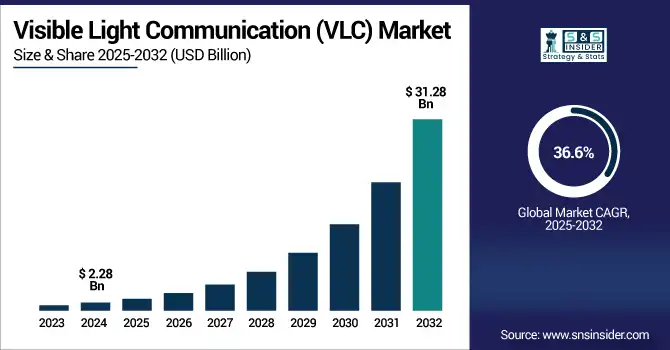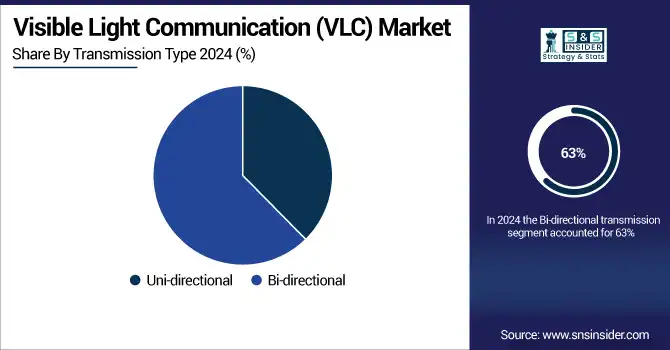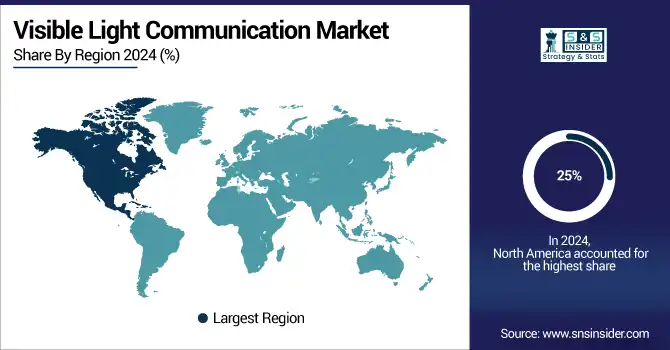Visible Light Communication (VLC) Market Report Scope & Overview:
The Visible Light Communication (VLC) Market Size was valued at USD 2.28 billion in 2024 and is expected to reach USD 31.28 billion by 2032 and grow at a CAGR of 36.6% over the forecast period 2025-2032.

To Get more information on Visible-Light-Communication-VLC-Market - Request Free Sample Report
The market is developing rapidly due to increasing demand for interference-free, high-speed speed and secure data connectivity. VLC utilizes LED light for transporting information and is a potential substitute for RF communication. Consumer electronics, automotive, defense, healthcare, and smart infrastructure are a few key industries seeing growing potential for the technology. Rapid urbanization, rising adoption of LED lighting and proliferation of IoT, and advancements in Li-Fi technology are also expected to spur market growth.
According to a recent study, more than 80% of today´s newly installed lighting systems globally are based on LED technology, which provides an excellent launching pad for VLC implementation. Further, the number of Li-Fi-enabled devices is set to exceed 1 billion devices by 2026, indicating increasing commercial and consumer usage. Average VLC throughput is also more than 10 Gbps, much higher than conventional Wi-Fi under some use cases were considered. Some 60-plus smart city pilot projects globally have integrated VLC-based infrastructure for uses including traffic management and indoor navigation.
The U.S. Visible Light Communication (VLC) Market size was USD 0.39 billion in 2024 and is expected to reach USD 4.09 billion by 2032, growing at a CAGR of 34.01% over the forecast period of 2025-2032. The primary factor that is driving the U.S. Visible Light Communication (VLC) market is the Increasing integration of LED lighting as a potential use case for urban VLC access points in the U.S. North America is the largest market for industrial 3D metrology, since the region has a strong infrastructure with the most advanced R&D facilities, and early adoption of new technologies. Moreover, government efforts for the implementation of Li-Fi in secure communications systems fuel the market growth and technological advancements in the region.
Market Dynamics:
Key Drivers:
-
Large-Scale Smart LED Rollouts Across U.S. Cities Drive Visible Light Communication (VLC) Market Growth
The accelerating rollout of smart LED lighting infrastructure across major U.S. cities is a primary driver of the Visible Light Communication (VLC) market. As governments and private sectors replace traditional lighting with connected, energy-efficient LED systems, the opportunity to embed VLC technology within this existing infrastructure becomes economically and technically viable. VLC leverages visible light from LEDs to transmit high-speed data securely and with low latency, offering a compelling alternative to radio-frequency-based systems. In urban environments, these dual-use networks support not only illumination but also advanced connectivity for smart city applications such as traffic management, parking systems, and public safety.
For instance, recent municipal retrofitting projects have included integrated VLC modules to enable real-time communication across dense city environments, unlocking efficiency without increasing the digital footprint. The expansion of smart lighting thus lays the groundwork for VLC technology to be scaled rapidly and cost-effectively in commercial and public infrastructure settings, boosting adoption and technological maturity across sectors.
Restraints:
-
High Deployment Costs and Complex System Integration Impede Widespread VLC Market Penetration
Despite its promising capabilities, the widespread adoption of VLC faces a key restraint in the form of high initial deployment costs and complex system integration. VLC systems require specialized hardware, including optical sensors, LED drivers, and compatible communication interfaces, all of which add to the upfront investment required by businesses or municipalities.
Additionally, integrating VLC into existing infrastructure, especially in legacy buildings or mixed-technology environments, demands tailored engineering solutions, which increases time-to-deployment and resource allocation. These factors can discourage adoption among smaller enterprises, educational institutions, and public organizations with limited budgets. The complexity is further compounded by the need for system compatibility across lighting, networking, and data management platforms, which may not have been designed with VLC in mind. As a result, even with growing interest in high-speed and interference-free communication, these cost and complexity barriers serve as significant friction points, delaying implementation timelines and limiting the technology’s reach in price-sensitive or highly regulated industries.
Opportunities:
-
Increased Demand for Interference-Free Communication in Healthcare Unlocks VLC Market Growth Potential
Healthcare environments are increasingly seeking wireless communication solutions that are immune to electromagnetic interference, which is a unique advantage of VLC systems. This creates a strong growth opportunity for VLC in critical care zones such as surgical suites, diagnostic labs, and MRI rooms, where conventional RF-based communication is often restricted. The ability of VLC to deliver secure, real-time data transmission without interfering with sensitive medical equipment makes it an ideal solution in this context.
Recently, healthcare facilities have started testing VLC networks for applications such as patient monitoring, real-time asset tracking, and staff coordination in high-sensitivity zones. These pilots have demonstrated not only improved data reliability but also enhanced operational efficiency in environments where other wireless technologies fall short. As hospital networks expand and digitization becomes central to modern healthcare delivery, VLC stands out as a viable and innovative alternative. This evolving demand across healthcare institutions opens a substantial pathway for VLC integration and long-term market expansion.
Challenges:
-
Signal Obstruction and Line-of-Sight Dependency Pose Operational Limitations to VLC Technology
A major challenge facing the VLC market is the technology’s dependence on direct line-of-sight between transmitter and receiver. Unlike RF signals, visible light cannot penetrate walls or opaque obstacles, making VLC vulnerable to disruptions caused by moving people, physical barriers, and dynamic room layouts. In practical deployment scenarios, such as retail stores, manufacturing floors, or open office environments, this constraint can severely impact signal continuity and user experience.
Maintaining stable connectivity requires precise lighting alignment and potentially redundant transmission points, which adds to infrastructure complexity and operational cost. Additionally, sudden ambient light changes or interference from other LED sources can impact signal clarity and require real-time adjustment mechanisms. These technical limitations necessitate advanced system designs and hybrid solutions to ensure consistent performance. Until robust solutions for mobility, auto-tracking, or fallback communication modes are universally implemented, these operational vulnerabilities remain a significant challenge to VLC scalability and usability in diverse real-world settings.
Segmentation Analysis:
By Component
Light Emitting Diodes (LEDs) lead the VLC Market in 2024 with a 43% revenue share, driven by widespread deployment in illumination and data communication and its ability to perform dual functions, lighting and data transmission, making it a foundational element of VLC systems. Its high efficiency, long life, and compatibility with modern lighting systems make LEDs a natural choice for smart lighting and VLC-based communication across homes, offices, hospitals, and vehicles. The segment’s leadership is reinforced by growing investments in smart cities and sustainable infrastructure, where energy-efficient lighting and high-speed connectivity converge.
Microcontrollers are projected to grow at the fastest CAGR of 42.14% Over 2025-2032, due to their essential role in processing VLC signals. Microcontrollers are vital to VLC technology as they manage signal processing, encoding, and communication protocols. Their compact size and integration flexibility make them suitable for embedded systems in consumer devices, lighting infrastructure, and medical equipment. As VLC applications become more complex, the demand for high-performance, energy-efficient microcontrollers rises, accelerating their growth. This trend is further amplified by the shift toward edge computing and autonomous control in VLC-enabled environments.
By Application
Public Infrastructure leads VLC applications in 2024 with 33% of total revenue, supported by growing smart city and smart lighting initiatives. The segment dominates as municipalities and government agencies implement VLC in street lighting, traffic systems, and building networks. VLC offers secure, interference-free communication in crowded RF environments, making it ideal for mission-critical urban applications. Its integration with LED-based lighting enables cost-effective deployment without the need for additional hardware, supporting environmental monitoring, pedestrian safety, and citywide communication in a spectrum-congested world.
Consumer Electronics is the fastest-growing application segment and is expected to grow at a CAGR of 41.27% through 2032, driven by high-speed wireless demands. This segment is accelerating as users seek faster, more secure wireless alternatives to traditional RF communication. VLC is being embedded in devices, such as smartphones, laptops, and AR/VR systems, providing high-bandwidth, and low-latency data transfer. Its immunity to electromagnetic interference makes it ideal for indoor environments, enhancing user experience in bandwidth-heavy applications such as media streaming, online gaming, and immersive digital interfaces.
By Transmission Type
Bi-directional transmission dominates the VLC Market with 63% revenue share in 2024, due to its support for full-duplex communication. The segment leads owing to allows simultaneous transmission and reception of data, enabling real-time applications in healthcare, industrial automation, and secure communications. This capability is critical for enterprise and defense environments, where high-speed, two-way data exchange is essential. The increasing demand for responsive, low-latency communication systems in structured indoor spaces continues to support the dominance of this segment.
Unidirectional transmission is growing at a CAGR of 39.12%, driven by its simplicity and effectiveness in one-way data dissemination. The unidirectional segment is expanding rapidly in use cases, such as indoor navigation, advertising, and information broadcasting. It is particularly useful in public places such as airports, malls, and museums, where VLC can transmit location-specific content to users without the need for back-channel communication. This segment benefits from lower complexity and cost, making it an attractive solution for organizations looking to enhance user engagement and operational efficiency through one-way data communication.

Regional Analysis:
North America holds a dominant visible light communication (VLC) market share25% share of the Visible Light Communication Market in 2024, driven by advanced LED infrastructure, increasing smart city initiatives, and growing demand for interference-free data transmission in dense environments. The U.S. leads the region, supported by strong government initiatives, a high adoption rate of Li-Fi in public and defense sectors, and robust R&D capabilities. With the rapid integration of VLC in smart lighting and connected infrastructure, the U.S. is reinforcing its leadership in the region’s VLC ecosystem.
Asia Pacific is the fastest-growing region in the Visible Light Communication Market in 2024, with a projected CAGR of 41.89% over 2025–2032. The region benefits from rising urbanization, LED adoption in commercial infrastructure, and strong governmental support for smart technologies. China dominates this growth due to its aggressive investment in smart cities, local manufacturing of VLC components, and broad deployment of IoT applications. Strong domestic players and public sector initiatives are accelerating VLC deployment, positioning China as the regional leader in innovation and large-scale implementation.
Europe remains a key contributor to the Visible Light Communication Market in 2024, fueled by EU-led energy efficiency mandates, digital infrastructure policies, and increasing use of VLC in public spaces and transportation. Germany leads the regional market, supported by industrial automation, automotive innovation, and smart mobility projects that incorporate Li-Fi for secure, high-speed communication. The country’s advanced R&D environment and support for emerging technologies are enhancing VLC penetration across both public and private sectors, solidifying its leadership position in Europe.
The Middle East & Africa and Latin America are emerging markets in the Visible Light Communication Market in 2024, driven by increasing demand for secure, high-speed communication and LED-based lighting systems. In the Middle East, the UAE, and Saudi Arabia are integrating VLC into smart city frameworks, including NEOM and urban transport. Meanwhile, Latin America sees traction in Brazil and Mexico, where public lighting upgrades and smart infrastructure projects are paving the way for VLC adoption in urban and commercial applications.

Get Customized Report as per Your Business Requirement - Enquiry Now
Key Players:
The Visible Light Communication (VLC) Market Companies are Koninklijke Philips NV, LVX System, Bytelight Inc. (Acuity Brands), Panasonic Corporation, PureLiFi Ltd., Oledcomm, Lucibel SA, Outstanding Technology Co. Ltd., Axrtek Company, Firefly Wireless Networks LLC, and others.
Recent Developments:
-
January 2024 – Philips is recognized as a key player in the VLC market. A January 15, 2024, Research‑Nester report listed “Koninklijke Philips NV” among major companies in the visible light communication market
-
July 2024 – LVX System signed a five-year agreement with NASA’s Kennedy Space Center to explore VLC applications. The partnership, initiated in July, aims to deploy VLC in classrooms and support future NASA space and ground communication research.
| Report Attributes | Details |
|---|---|
| Market Size in 2024 | USD 2.58 Billion |
| Market Size by 2032 | USD 31.28 Billion |
| CAGR | CAGR of 36.6% From 2025 to 2032 |
| Base Year | 2024 |
| Forecast Period | 2025-2032 |
| Historical Data | 2021-2023 |
| Report Scope & Coverage | Market Size, Segments Analysis, Competitive Landscape, Regional Analysis, DROC & SWOT Analysis, Forecast Outlook |
| Key Segments | by Component (Light Emitting Diodes, Photodetectors, Microcontrollers, Software and Services), Transmission Type (Uni-directional, Bi-directional), and Application (Consumer Electronics, Defense and Security, Transportation, Public Infrastructure, Life Sciences, and Other Applications) |
| Regional Analysis/Coverage | North America (US, Canada, Mexico), Europe (Germany, France, UK, Italy, Spain, Poland, Turkey, Rest of Europe), Asia Pacific (China, India, Japan, South Korea, Singapore, Australia, Taiwan, Rest of Asia Pacific), Middle East & Africa (UAE, Saudi Arabia, Qatar, South Africa, Rest of Middle East & Africa), Latin America (Brazil, Argentina, Rest of Latin America) |
| Company Profiles | Koninklijke Philips NV, LVX System, Bytelight Inc. (Acuity Brands), Panasonic Corporation, PureLiFi Ltd., Oledcomm, Lucibel SA, Outstanding Technology Co. Ltd., Axrtek Company, Firefly Wireless Networks LLC, and Others. |

